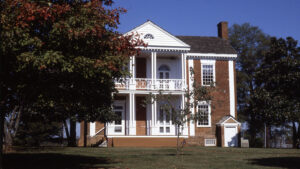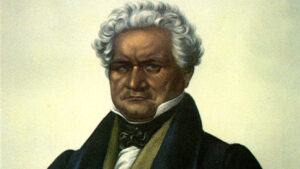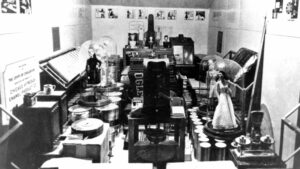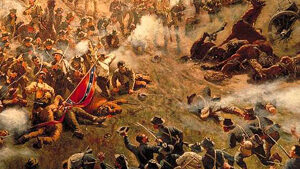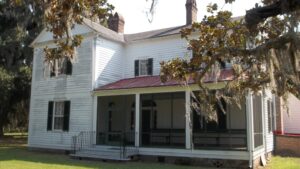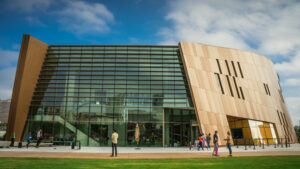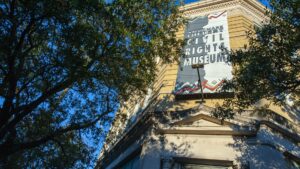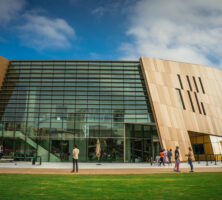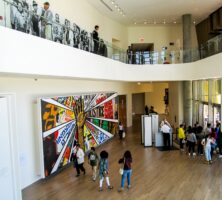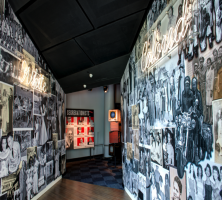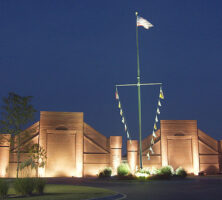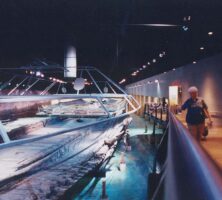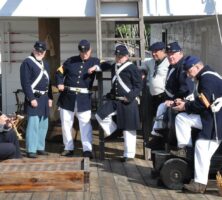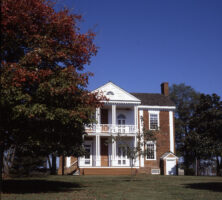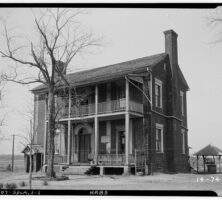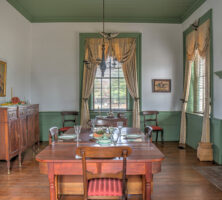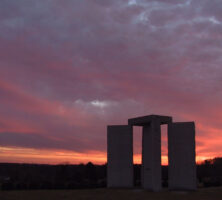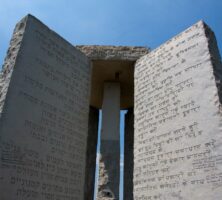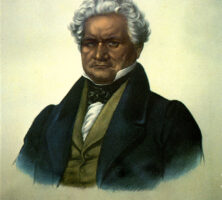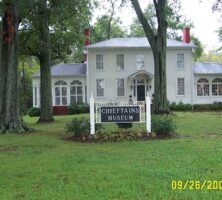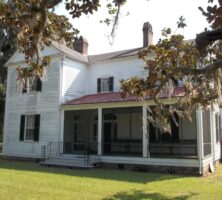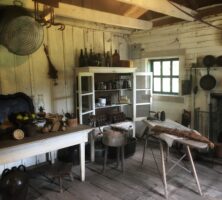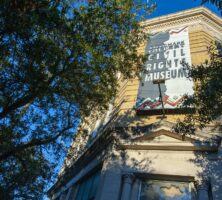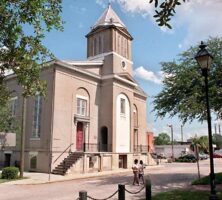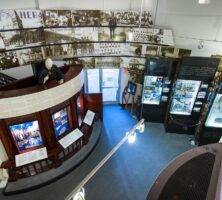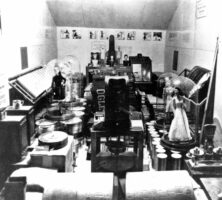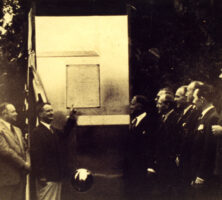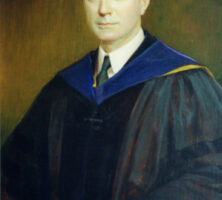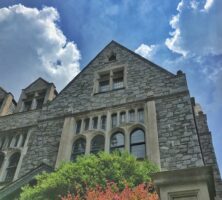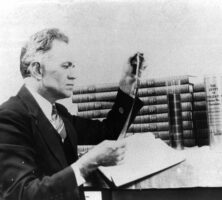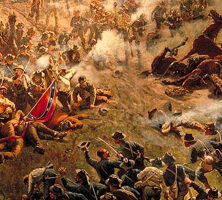The New Georgia Encyclopedia is supported by funding from A More Perfect Union, a special initiative of the National Endowment for the Humanities.
Located in downtown Atlanta, the National Center for Civil and Human Rights (NCCHR) is a museum that explores the connections between the U.S. civil rights movement and the global struggle for human rights.
Photograph by Bradley Huchteman
The New Georgia Encyclopedia does not hold the copyright for this media resource and can neither grant nor deny permission to republish or reproduce the image online or in print. All requests for permission to publish or reproduce the resource must be submitted to the rights holder.
The NCCHR's 42,000 square-foot facility opened in 2014 and receives approximately 200,000 visitors each year.
Photograph by Marco Correa
The New Georgia Encyclopedia does not hold the copyright for this media resource and can neither grant nor deny permission to republish or reproduce the image online or in print. All requests for permission to publish or reproduce the resource must be submitted to the rights holder.
The center's primary exhibit, "Rolls Down Like Water: The American Civil Rights Movement," incorporates historical images, oral histories, and film footage alongside interactive features.
Photograph from the National Center for Civil and Human Rights
The New Georgia Encyclopedia does not hold the copyright for this media resource and can neither grant nor deny permission to republish or reproduce the image online or in print. All requests for permission to publish or reproduce the resource must be submitted to the rights holder.
The annual "RiverBlast" celebration is held in early March to commemorate the anniversary of the National Civil War Naval Museum at Port Columbus.
Courtesy of National Civil War Naval Museum at Port Columbus
The New Georgia Encyclopedia does not hold the copyright for this media resource and can neither grant nor deny permission to republish or reproduce the image online or in print. All requests for permission to publish or reproduce the resource must be submitted to the rights holder.
The National Civil War Naval Museum at Port Columbus opened its doors in 2001. Located on the Chattahoochee River in Columbus, the museum features Civil War ships and maritime artifacts within its 40,000 square feet.
Courtesy of National Civil War Naval Museum at Port Columbus
The New Georgia Encyclopedia does not hold the copyright for this media resource and can neither grant nor deny permission to republish or reproduce the image online or in print. All requests for permission to publish or reproduce the resource must be submitted to the rights holder.
In 1865 the Union army set fire to the unfinished CSS Jackson and set it adrift in the Chattahoochee River, where it burned for two weeks. The ship was raised in 1961 and is housed today at the National Civil War Naval Museum at Port Columbus.
Courtesy of National Civil War Naval Museum at Port Columbus
The New Georgia Encyclopedia does not hold the copyright for this media resource and can neither grant nor deny permission to republish or reproduce the image online or in print. All requests for permission to publish or reproduce the resource must be submitted to the rights holder.
A Confederate Brooke Rifle is fired regularly outside of the National Civil War Museum at Port Columbus. The gun was built in 1865 at the Confederate Navy Works in Selma, Alabama, and was brought to the Confederate Navy Shipyard in Columbus for use on the CSS Jackson.
Courtesy of National Civil War Naval Museum at Port Columbus
The New Georgia Encyclopedia does not hold the copyright for this media resource and can neither grant nor deny permission to republish or reproduce the image online or in print. All requests for permission to publish or reproduce the resource must be submitted to the rights holder.
Reenactors portraying marines and soldiers are pictured on the replica of the USS during RiverBlast 2010 at the National Civil War Naval Museum at Port Columbus.
Courtesy of National Civil War Naval Museum at Port Columbus
The New Georgia Encyclopedia does not hold the copyright for this media resource and can neither grant nor deny permission to republish or reproduce the image online or in print. All requests for permission to publish or reproduce the resource must be submitted to the rights holder.
Called the "Showplace of the Cherokee Nation," this two-story classic mansion is one of the best-preserved Cherokee plantation homes. Built by Chief James Vann in 1806, it was the first brick home within the Cherokee Nation. The mansion is a state historic site.
Courtesy of Atlanta History Center.
The New Georgia Encyclopedia does not hold the copyright for this media resource and can neither grant nor deny permission to republish or reproduce the image online or in print. Requests for permission to publish or reproduce the resource should be submitted to the Atlanta History Center.
In 1834 Cherokee chief James Vann's son Joseph lost the family home to the state. The home was subsequently owned by seventeen people and had fallen into a state of disrepair before its 1952 purchase and restoration by the Georgia Historical Commission.
Courtesy of Library of Congress, Prints and Photographs Division
The New Georgia Encyclopedia does not hold the copyright for this media resource and can neither grant nor deny permission to republish or reproduce the image online or in print. All requests for permission to publish or reproduce the resource must be submitted to the rights holder.
In the 1950s the Georgia Historical Commission undertook a renovation of the Chief Vann House in Murray County, restoring the blue, red, green, and yellow color scheme originally used throughout the house.
Image from Dsdugan
The New Georgia Encyclopedia does not hold the copyright for this media resource and can neither grant nor deny permission to republish or reproduce the image online or in print. All requests for permission to publish or reproduce the resource must be submitted to the rights holder.
The New Georgia Encyclopedia does not hold the copyright for this media resource and can neither grant nor deny permission to republish or reproduce the image online or in print. All requests for permission to publish or reproduce the resource must be submitted to the rights holder.
Known as "America's Stonehenge," the Georgia Guidestones in Elbert County were unveiled on March 22, 1980, after a mysterious man known as R. C. Christian commissioned a local company to engrave the stones with ten maxims to "an age of reason." The text on the guidestones was presented in twelve different languages.
Photograph by Melinda Smith Mullikin, New Georgia Encyclopedia
The New Georgia Encyclopedia does not hold the copyright for this media resource and can neither grant nor deny permission to republish or reproduce the image online or in print. All requests for permission to publish or reproduce the resource must be submitted to the rights holder.
The Georgia Guidestones formed a granite monument that stood on one of the highest hilltops in Elbert County. The monument's four supporting stones were each more than sixteen feet tall and bore ten guides dealing with government, population control, the environment, and spirituality.
Image from Kevin Trotman
The New Georgia Encyclopedia does not hold the copyright for this media resource and can neither grant nor deny permission to republish or reproduce the image online or in print. All requests for permission to publish or reproduce the resource must be submitted to the rights holder.
Hand-colored lithograph of Major Ridge, a Cherokee leader who helped establish the Cherokee system of government. The soldier, politician, and plantation owner is remembered for signing the Treaty of New Echota (1835), which ceded Cherokee lands to the U.S. government and authorized Cherokee removal.
From History of the Indian Tribes of North America, by T. McKenney and J. Hall
The New Georgia Encyclopedia does not hold the copyright for this media resource and can neither grant nor deny permission to republish or reproduce the image online or in print. All requests for permission to publish or reproduce the resource must be submitted to the rights holder.
The Cherokee leader Major Ridge and his family lived in this house, near present-day Rome, in the early 1800s. The house was part of Ridge's 280-acre plantation. Today, the historic site is a museum.
Courtesy of Alice Taylor-Colbert, Shorter University. Reprinted by permission of Chieftains Museum
The New Georgia Encyclopedia does not hold the copyright for this media resource and can neither grant nor deny permission to republish or reproduce the image online or in print. All requests for permission to publish or reproduce the resource must be submitted to the rights holder.
The former rice plantation dates to 1806, and the Hofwyl House, built in 1850 by descendants of planter William Brailsford, still stands.
Image from Ebyabe
The New Georgia Encyclopedia does not hold the copyright for this media resource and can neither grant nor deny permission to republish or reproduce the image online or in print. All requests for permission to publish or reproduce the resource must be submitted to the rights holder.
When the Hofwyl-Broadfield plantation was willed to the state in 1973, the owners left antiques collected by the family for more than five generations. Such household items are on display at the historic site.
Image from Wendy
The New Georgia Encyclopedia does not hold the copyright for this media resource and can neither grant nor deny permission to republish or reproduce the image online or in print. All requests for permission to publish or reproduce the resource must be submitted to the rights holder.
The museum is named for Ralph Mark Gilbert, a Savannah leader of the civil rights movement. Gilbert served as president of the Savannah NAACP for eight years.
Courtesy of Explore Georgia, Photograph by Geoff L. Johnson.
The New Georgia Encyclopedia does not hold the copyright for this media resource and can neither grant nor deny permission to republish or reproduce the image online or in print. Requests for permission to publish or reproduce the resource may need to be submitted to Explore Georgia.
The New Georgia Encyclopedia does not hold the copyright for this media resource and can neither grant nor deny permission to republish or reproduce the image online or in print. All requests for permission to publish or reproduce the resource must be submitted to the rights holder.
First African Baptist Church, which was established during the 1770s, played an important part in the Savannah civil rights movement. The stained-glass windows in the current church building, located at 23 Montgomery Street in Savannah, feature prominent Black leaders.
Photograph by Carl Elmore. Courtesy of Savannah Morning News
The New Georgia Encyclopedia does not hold the copyright for this media resource and can neither grant nor deny permission to republish or reproduce the image online or in print. All requests for permission to publish or reproduce the resource must be submitted to the rights holder.
Through various kinds of displays, the museum chronicles the civil rights struggle of Georgia's oldest African American community.
Courtesy of Explore Georgia, Photograph by Geoff L. Johnson.
The New Georgia Encyclopedia does not hold the copyright for this media resource and can neither grant nor deny permission to republish or reproduce the image online or in print. Requests for permission to publish or reproduce the resource may need to be submitted to Explore Georgia.
The art deco door that seals the Crypt of Civilization features a plaque with an elaborate message written by Thornwell Jacobs and a "moon hubcap" decoration.
Courtesy of Oglethorpe University Archives
The New Georgia Encyclopedia does not hold the copyright for this media resource and can neither grant nor deny permission to republish or reproduce the image online or in print. All requests for permission to publish or reproduce the resource must be submitted to the rights holder.
The interior of the swimming pool-sized time capsule is filled with contents intended to represent an encyclopedic record of life and customs up until 1940, when the crypt was sealed. The crypt's interior resembles a pyramid chamber, and pictographs decorate the walls.
Courtesy of Oglethorpe University Archives
The New Georgia Encyclopedia does not hold the copyright for this media resource and can neither grant nor deny permission to republish or reproduce the image online or in print. All requests for permission to publish or reproduce the resource must be submitted to the rights holder.
The dedication of the crypt door took place on the Oglethorpe University campus on May 28, 1938. The art deco door, with its rectangular shapes and "moon hubcap" decoration, was considered a work of industrial art. (Thornwell Jacobs is pictured pointing at the door flanked on his right by David Sarnoff and T. K. Peters.)
Courtesy of Oglethorpe University Archives
The New Georgia Encyclopedia does not hold the copyright for this media resource and can neither grant nor deny permission to republish or reproduce the image online or in print. All requests for permission to publish or reproduce the resource must be submitted to the rights holder.
Thornwell Jacobs became the president of Oglethorpe University in 1915. Jacobs is depicted in academic regalia in a painting by the portraitist Charles Naegle.
Courtesy of Oglethorpe University Archives
The New Georgia Encyclopedia does not hold the copyright for this media resource and can neither grant nor deny permission to republish or reproduce the image online or in print. All requests for permission to publish or reproduce the resource must be submitted to the rights holder.
Phoebe Hearst Hall, built in 1915, is Gothic revival in design and was renovated in 1972. The most dominant feature of Oglethorpe University campus architecture, the hall was built in honor of Phoebe Apperson Hearst, mother of the benefactor and publisher William Randolph Hearst Sr. The Crypt of Civilization is housed on the lower level.
Image from Oglethorpe University
The New Georgia Encyclopedia does not hold the copyright for this media resource and can neither grant nor deny permission to republish or reproduce the image online or in print. All requests for permission to publish or reproduce the resource must be submitted to the rights holder.
Inventor, photographer, and crypt archivist T. K. Peters examines the crypt's microfilm. Peters was the only newsreel photographer to film the San Francisco earthquake and fire of 1906 and the construction of the Panama Canal. After the crypt project, he restored the collection of Confederate flags in Georgia's capitol.
Courtesy of Oglethorpe University Archives
The New Georgia Encyclopedia does not hold the copyright for this media resource and can neither grant nor deny permission to republish or reproduce the image online or in print. All requests for permission to publish or reproduce the resource must be submitted to the rights holder.
Cyclorama is the name given to the huge painting depicting the Civil War battle fought on July 22, 1864, east of Atlanta. The painting depicts a view of the battle from just inside the Fifteenth Corps lines at about 4:30 p.m. on July 22. (Only a small portion of the painting is pictured.)
Courtesy of Georgia Department of Economic Development.
The New Georgia Encyclopedia does not hold the copyright for this media resource and can neither grant nor deny permission to republish or reproduce the image online or in print. Requests for permission to publish or reproduce the resource may need to be submitted to the Georgia Department of Economic Development.
The New Georgia Encyclopedia does not hold the copyright for this media resource and can neither grant nor deny permission to republish or reproduce the image online or in print. All requests for permission to publish or reproduce the resource must be submitted to the rights holder.
